Welcome to the 14th installment of my article series, Track Breakdowns.
In this series, I look at the theory and arrangement behind popular songs, ultimately showing you what makes each song work.
In this breakdown, we’ll look at Droeloe’s track Many Words.
This breakdown will look a bit different then previous articles in this series.
First, we’ll dive deep into the intro pluck melody in Many Words, understanding how and why it works.
Second, we’ll discuss a framework to write a melody in this style. I’ll show you a real world example of how to turn a basic 4-bar chord progression into a Droeloe style pluck melody.
You can preview the finished product below:
Lastly, we’ll discuss the key songwriting and arrangement techniques used in this track, looking at what makes Droeloe’s music so catchy and memorable.
Let’s get to it.
Get 25 high-quality MIDI chord progression files for free 🎹
Our Track Breakdown MIDI Vault is packed with chord progression MIDI files from songs like Mura Masa’s ‘Lovesick’, Flume’s ‘Say It’ & more! 👇
The Sauce
Many Words is in the key of B Major.


Let’s start with the intro melody used in this track.

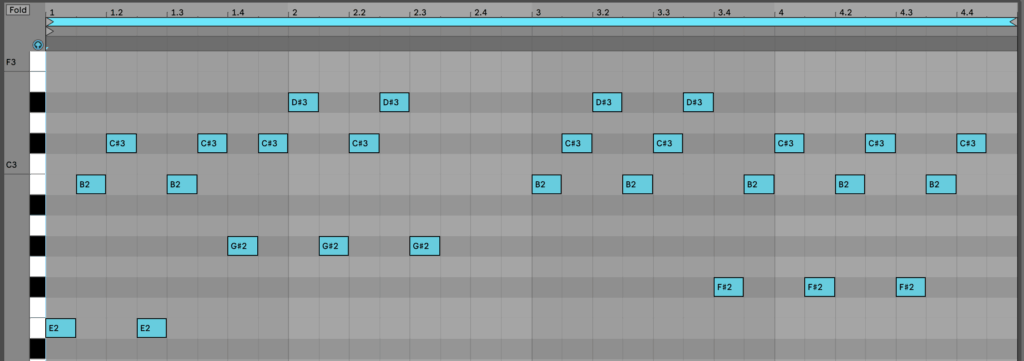
We can group this melody into four distinct motifs.
I’ve outlined them below.

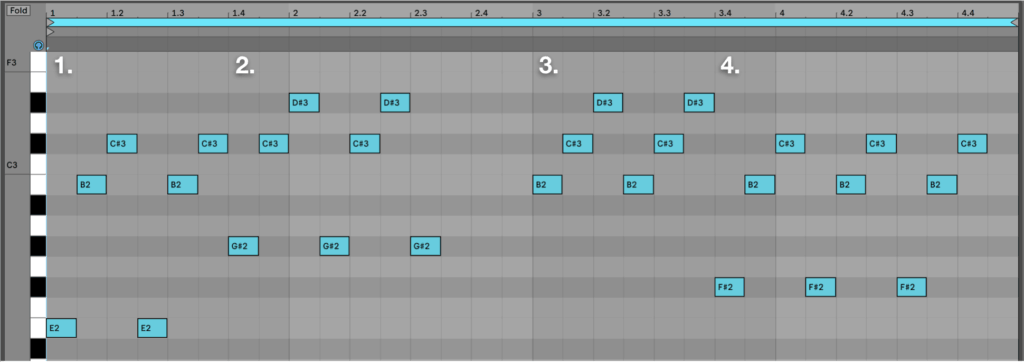
We can treat this melody as type of arpeggio.
(Even if you’re already familiar with arpeggios, don’t skip ahead as I explain them with a unique lens.)
An arpeggio describes when you take a chord and play the notes individually, rather than at the same time.
Below is an example of an Am7 chord played first as a block chord then as an arpeggio.
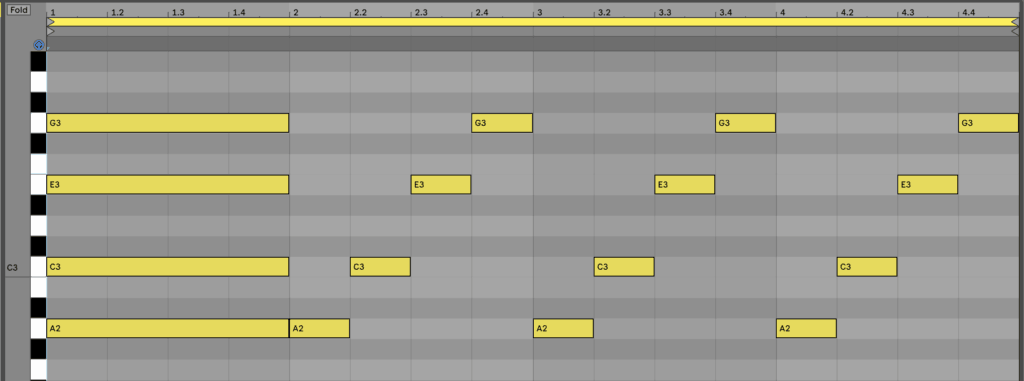

Even though the notes of an arpeggio are spread out, the listener still connects them as forming a single chord.
In the example above, a listener would perceive that arpeggio to be a full Am7 chord, even though the notes are hitting separately.
Arpeggios are powerful because they can imply harmony through melody.
This is great because it allows you to craft the harmonic development all great songs are rooted in with the dynamic movement of a melody.
This is a popular technique among many pop-friendly electronic artists like Louis The Child, Whethan, and Droeloe. They’ll use melodies, arpeggios, and baselines to imply their chord progressions, rather than presenting the chord progression outright.
If you’re still stuck on how a melody can imply a chord, check out this video.
Let’s look at exactly how Droeloe does this in Many Words.
Melody Implying Harmony
As mentioned above, the intro melody in Many Words implies a full 4 bar chord progression.
Take a listen to it below.


Let’s dissect this melody to figure out what chords are being implied.
(In the next section, we’ll do this in reverse, where we’ll build a melody out of a basic chord progression.)
In a typical arpeggio, you’ll run up or down the notes of that chord.
That’s what I did in my Am7 arpeggio example, where I played the notes of Am7 (A – C – E – G) as a sequence of ascending quarter notes.


While this style of arpeggio works well, it can often sound too much like an arpeggio and not enough like a melody.
Why is this?
Playing the notes of a chord in succession with a static rhythm is stale and predictable.
This style of arpeggio works well in some cases, but is rarely interesting enough to be the main hook in a track.
However, you can use an arpeggio as a starting point to craft an interesting melody that’s rooted in the movement of your chord progression.
For example, take the following arpeggio that moves from Am (A – C – E) to F (F – A – C).

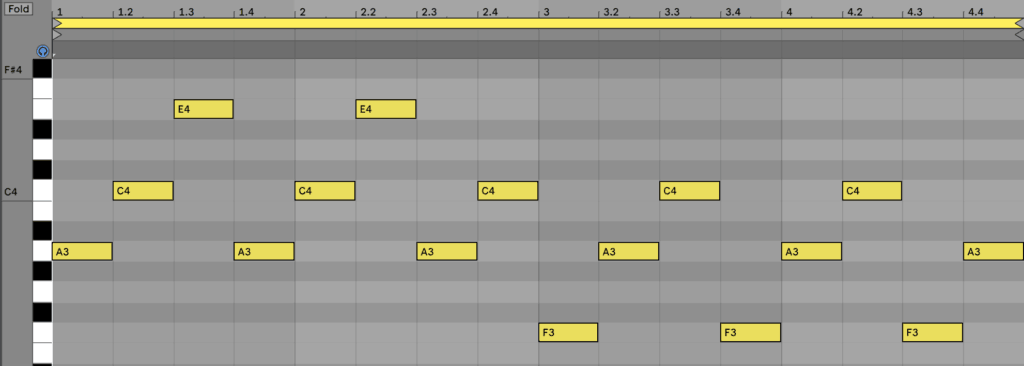
This arpeggio sounds fine, but it’s nothing too special.
A great way to spice up an arpeggio is to move certain notes to other notes in the scale.
You’ll likely want to keep the root note the same to establish the bass note of each chord, but outside of this experiment by moving the other chord tones to different notes in the scale.
Below, I’ve taken the middle note from Am and moved it up to a D, and I moved the top note from F major up to a D as well.

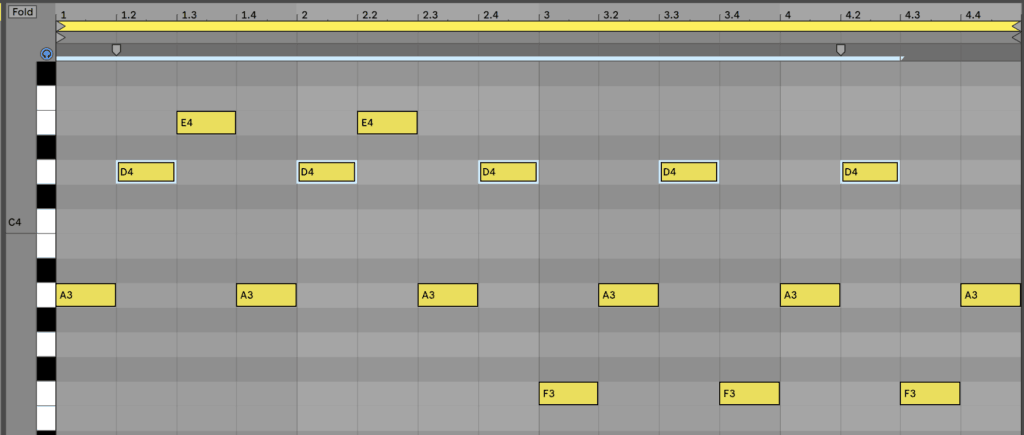
Notice how this sounds much less robotic then the previous example. It still implies the Am-F chord progression, but it does so in a more unique and creative way.
This is because this arpeggio has a balance of chord tones and non-chord tones: non-chord tones that add tension, and chord tones that resolve that tension.
(Click here to learn more about chord tones and non-chord tones)
Droeloe uses a similar technique in their track Many Words.
If we assume the lowest note in each motif is the base, we can infer what chords they are outlining.


The chord implied by the first motif is E major, which contains the notes E, G#, and B. The melody plays both E and B (the root and fifth), alongside the non-chord tone C# (remember, non-chord tones are notes that are not in the chord, but still in the scale).
The first motif outlines the structure of an E major triad without spelling out the chord completely. This disguises the chord, making it more interesting than a standard ascending arpeggio.
The chord implied by the second motif is G#m, which contains the notes G#, B, and D#. The motif plays both the root (G#) and fifth (D#), but opts for a C# instead of a B.
The chord implied by the third motif is B major, and the chord implied by the fourth motif is F# major.
This makes the full progression: E – G#m – B – F#.
Numerically (in the key of B), this is IV – vi – I – V.
You can hear the sustained version of this chord progression below.
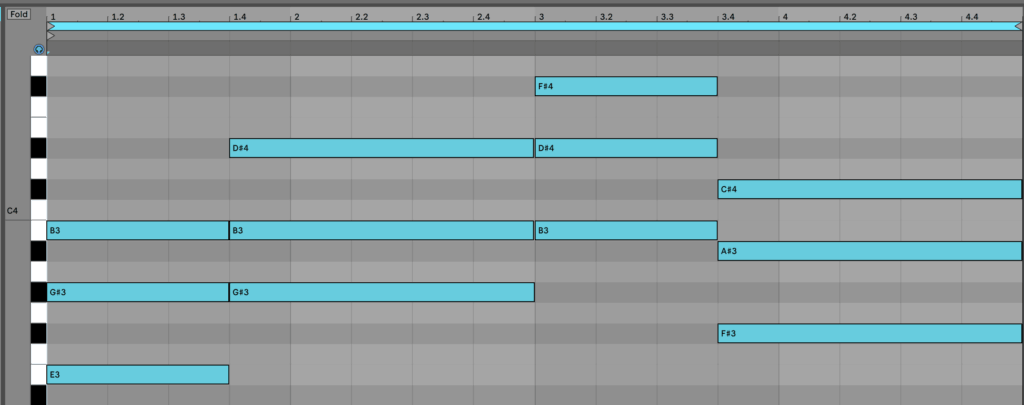

By itself, this progression isn’t that interesting.
In fact, it is really just a rearrangement of the most common progression in pop, the I – V – vi – IV progression made famous by the Axis Of Awesome’s “4 Chords” music video.
However, even though this chord progression is quite basic, the way they phrased is not.
Using many of the techniques described above, Droeloe was able to build off of this chord progression to craft a catchy and memorable melody.
In fact, many of the most commercially successful electronic music producers use this same technique.
They’ll take time-tested pop-chord progressions and disguise them, presenting them in a new way.
They’ll use the same four chords as a typical Taylor Swift or Katy Perry track, but build off of that with a creative and unique production.
Artists like Louis the Child and Illenium are notorious for this.
The way that I see it, rather than being great songwriters, these artists are great producers who know how to pair traditional pop techniques with a fresh and innovative production.
Droeloe-Style Melody Writing Example
Now that we’ve dissected what makes the intro melody in Droeloe’s Many Words work, let’s look at an example of how to build a similar styled melody from scratch.
The framework is straightforward:
- Start with a 4 bar, 4 chord progression.
- Create an ascending arpeggio using the notes in each chord.
- Rearrange some of the top notes in each arpeggio to deviate from the standard 1-3-5 pattern. Be sure to use non-chord tones, which are notes that aren’t in the chord but are still in the scale.
Let’s look at this framework in action.
First, I’ll need to write a chord progression.
Below, I have basic chord progression in the key of C Minor.
The progression is: Cm – Bb – Ab – Fm
Numerically, it is i – VII – VI – iv.
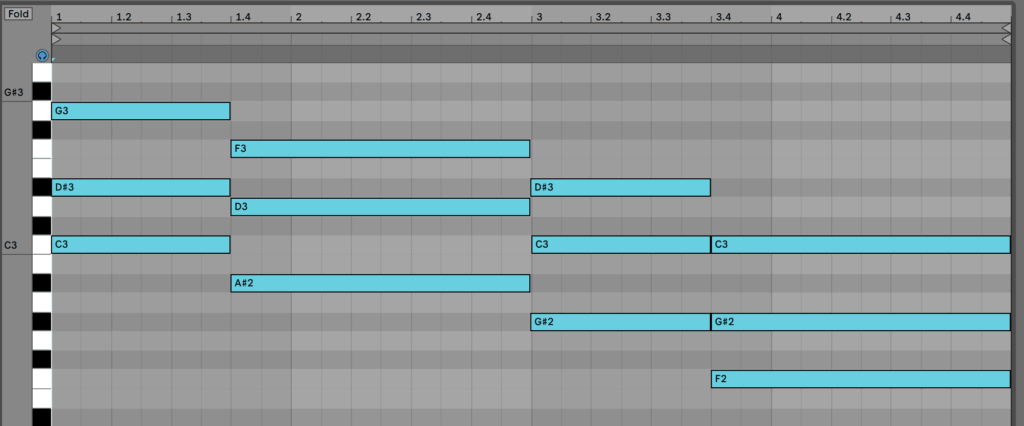

Next, I’ll create an ascending arpeggio using the notes from each chord using an 1/8th note rhythm. With each chord, I’m simply moving from the root to the third to the fifth, using a 1-3-5 pattern.

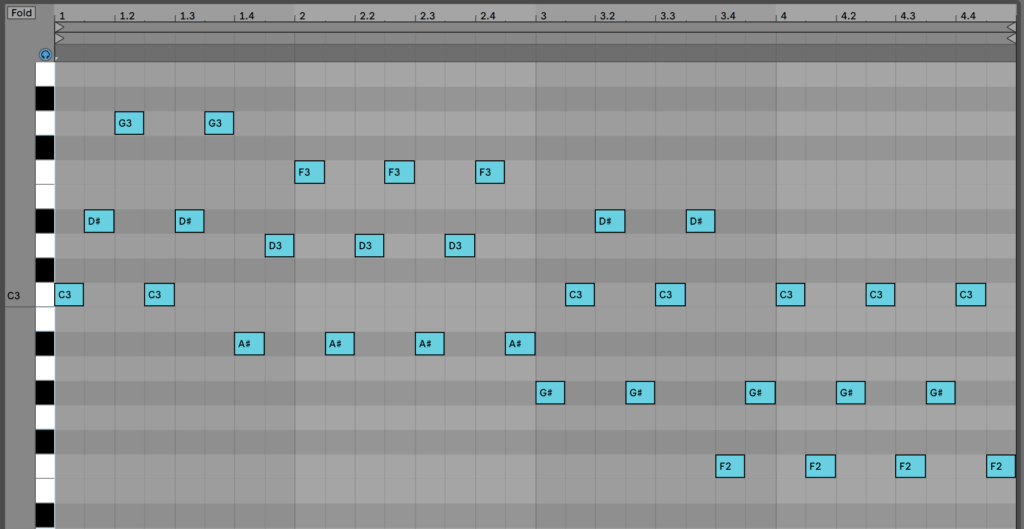
Now that I have the arpeggio in place, I’ll move to the third step, which is to rearrange some of the top notes in each chord.
The key to this step is experimentation. I’ll simply use my ear to find other notes in the scale that work for each arpeggio.
Below is the finished product.
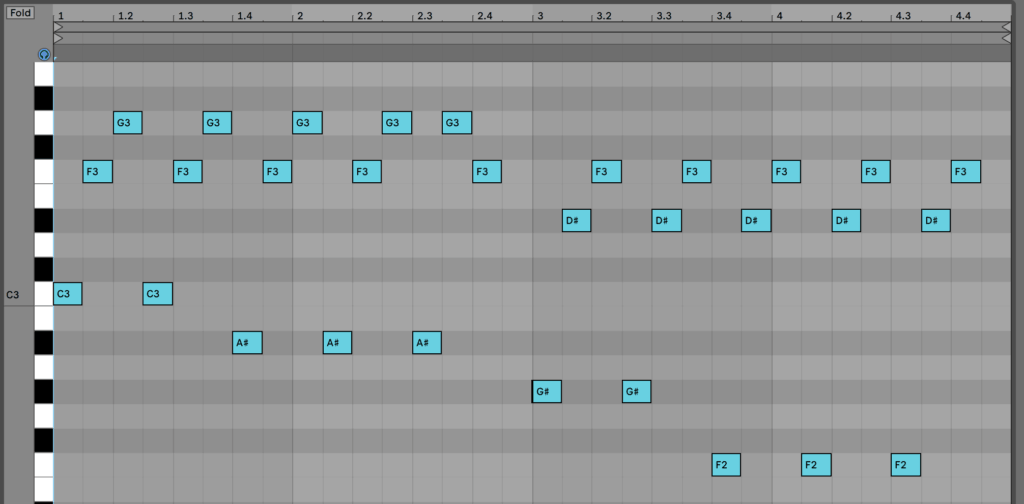
In the original arpeggio, I used a 1-3-5 pattern for each chord, simply playing the root, third, and fifth of each chord.
In the edited version, the pattern for each chord is:
- Cm: 1 – 4 – 5
- Bb: 1 – 5 – 6
- Ab: 1 – 5 – 6
- Fm: 1 – 7 – 8
There’s nothing special about the exact patterns I chose. I simply used my ear and experimented until I found a melody that worked.
To help contextualize this melody, let’s listen to it with a Droeloe-esque production.
Normally I don’t do production examples in my track breakdowns, but I felt it was particularly important to this analysis.
First, I swapped the piano for a percussive melodic instrument. Specifically, I used the “Resonator Zim’bira Finger” preset from Omnisphere 2.
From there, I duplicated this instrument and pitched it an octave higher. Then, I made subtle adjustments to this melody, adding a few more embellishments to differentiate it from the main melody.
Lastly, I added a basic baseline that follows the root notes of the chords and added a bit of ambient noise.
Together, these add up to the finished example.
You can find the MIDI from this example in the Track Breakdown MIDI Vault.
It’s worth mentioning that you should use this framework as a reference, not as a definitive guide on how to write a melody.
This guide works well as a practical exercise, but sticking strictly to this framework will find you sounding just like Droeloe, which isn’t the goal – the goal is to sound like you.
Your goal should be to take these techniques and build off of them, finding new approaches to songwriting and arrangement.
The most successful artists know how to borrow elements from other artists and put their own spin on it.
Challenge yourself to develop upon the techniques that you’ve learned throughout this article.
To close out, let’s look at a few essential songwriting and arrangement techniques used by Droeloe in Many Words.
Songwriting and Arrangement Takeaways
Tip One: Many Hooks
The linear arrangement of Many Words is one of the most impressive aspects of this song.
This track has an incredibly smooth flow even though it never repeats a section.
Every verse and every chorus is unique.
They repeat certain melodic and harmonic ideas, but the production and arrangement of each section is distinct.

Listen back to the original, and notice how all three verses are different and how all three choruses are different.
This contributes heavily to the emotional development of this track. The development and variation of each section keeps the listener interested and engaged.
Rather then copy-pasting the first verse and chorus (which they easily could have done), they choose to push themselves, crafting a new idea for each section.
While no two sections are the same, that doesn’t mean there isn’t any repetition.
They continually rephrase and recycle melodies, playing them with different instruments and making adjustments to make them fit in context.
For example, the main vocal chant is played multiple times throughout the arrangement.

The melody of the vocal chant mirrors the melody of the main pluck in the chorus.
The pluck melody is a slightly more complex version of the vocal chant melody, but the two are closely related.
Below is a transcription of this pluck melody. Much like the vocal, it is played multiple times throughout the arrangement.

What can you take away from this?
A large part of Droeloe’s success is an exceptional attention to detail.
This makes their music feel more like a song then just a track.
This is an attention to detail seen throughout the music I’ve analyzed in my track breakdown series.
Most of the artists I’ve covered aren’t music theory or songwriting virtuosos; rather they have an attention to detail that allows them to make the most of a basic understanding of music theory.
Tip Two: Many Melodies
Another thing that Droeloe is known for is their intricate countermelodies.
Throughout Many Words, there are various countermelodies that play off of the core melodic idea in each section.
So how do you write an effective countermelody?
The traditional way is to understand the theory behind counterpoint, which describes the rules behind combining multiple different melodies.
However, the theory behind counterpoint is quite dense, making it out of reach for most producers.
As with everything in music theory, counterpoint relates the theory to what sounds good. In other words you can write a great counter melody without knowing any of the theory.
However, writing a good counter melody is easier said than done.
To help guide you, let’s look at a few counter melody writing tips, inspired by the melodies countermelodies in Many Words.
The first tip is to have a clear focus in each section.
Many beginners will write countermelodies that detract from the main melody, pulling focus away from that hook. This is typically a poor choice because you want your main melody to be the focus of your song.
If you have a countermelody that pulls away focus from the lead vocal, the vocal will be harder to pick out, which will weaken the strength of that track.
To summarize: a good countermelody should support what already exists in the track.
In many of Droeloe’s tracks, their countermelodies are quite simple and static.
This helps to tuck them into the background where they can add texture and density without pulling away focus from the lead melody.
The first verse in Many Words is a great example of this. Eight bars into the first verse, there are four predominant melodies. Take a listen to it in the original (0:25-0:38).
There is a lead pluck, a vocal chant, an electric guitar, and a bass guitar.
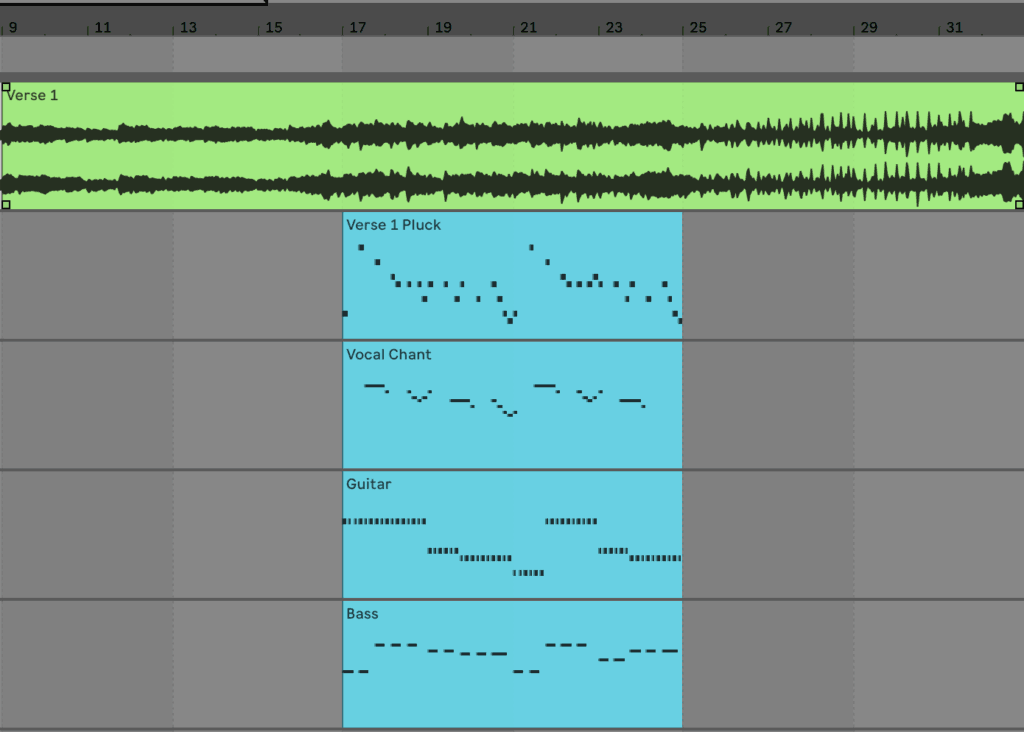
Pluck:
Vocal Chant:
Electric Guitar:
Bass Guitar:
Even though each melody is different, they work extremely well together.
Why?
Because they each have a specific function that contributes to the track as a whole.
For example, take the bass guitar.
The pattern of the bassline is simple and repetitive. While the bass pattern isn’t interesting, it’s not meant to be the lead focus. It’s meant add rhythm and body to the track. In other words, it serves it’s purpose.
The same goes for the electric guitar. By itself it’s quite boring, but it helps add texture and depth to the mix. It’s not the lead focus, but it contributes to the overall vibe of that section.
And as I mentioned earlier, the melodies of the pluck and vocal chant are very similar.
They help support each other, rather then fighting each other for the listeners attention.
To reiterate: each melody in this section has a specific function.
The bass and electric guitars help add groove and depth to the mix, while the vocal chant directly supports the pluck by playing a stripped down version of that same melody.
When writing a countermelody, think about how it can help contribute to the elements already present in your track.
Tip Three: Extended Progressions
Droeloe uses extended progressions throughout this track.
The basic idea behind an extended progression is to take a complete 4 bar chord progression, duplicate it, then make meaning changes to the second half.
The goal is to create an idea that is new, but familiar. It’s familiar, because it’s relates back to the first half, but new, because there is some degree of variation.
Droeloe does a ton of this in Many Words. In the second half of nearly every 8 bar section, they’ll make changes to the bassline, melodies, or drums to add variation and development.
The chorus bassline is a perfect example of this.
Instead of simply repeating the first 4 bars, they made subtle adjustments to the pattern and rhythm.

There are similarities that offer an element of repetition, but adjustments that add development and variation.
The key adjustment is to the core root movement. Ignoring the embellishments, the bass pattern in the first four bars is E-C#-B-F#. In the second half, it switches to E-C#-G#-B.
The first two bass notes are the same in each half, while the latter two are different. This helps create development that feels natural and familiar.
If you want to learn about when and why to use extended progressions, check out my recent breakdown of Petit Biscuit and Lido’s track Problems.
Otherwise, there are a lot of extra transcriptions from this song I wasn’t able to cover in this article, so be sure to download them below if you’d like to dive deeper into this track.
Want free access to the Track Breakdown MIDI Vault? You can download the MIDI from all of our Track Breakdowns, as well as 25 hi-quality MIDI chord progressions you can use in your own productions.
Get 25 high-quality MIDI chord progression files for free 🎹
Our Track Breakdown MIDI Vault is packed with chord progression MIDI files from songs like Mura Masa’s ‘Lovesick’, Flume’s ‘Say It’ & more! 👇
Conclusion
I hope you were able to take away some useful tips and techniques from this article.
I tried to pull out as much valuable information as I could from this song, helping you to better understand what makes a great song, great.
Lastly, if there are any songs you’d like covered, please let me know!
Want to read more breakdowns? Click here to visit the Track Breakdown Glossary.

